Creating content that stands out from the crowd
Contents

SEO, Email, Social Media advertising. What do they all have in common? They all need great content to succeed.
The power of content
Content is one of the most versatile tools available to Digital Marketers. Not only can it fuel other channels, it can also be angled to fit a variety of different objectives and audiences.
The key is knowing your objective, knowing your audience and knowing how to put your content in front of those people.

The Digital Marketing space is cluttered with content – your content will always be competing, either directly with your competitors or simply with other content that might draw the attention of potential readers.
“On a given day, when the average person visits their News Feed, there are an average of 1,500 possible stories we can show. As a result, competition for each News Feed story is increasing.” Facebook Executive, Richard Sim

Like every channel in the Digital Marketing mix, Content Marketing has gone through a period of maturation. Just as strategies like keyword stuffing for SEO have become outdated, it’s no longer as simple as just creating content and expecting it to achieve results.
Content now needs to be created with your audience in mind and needs to offer them something of value that will attract their attention.
If it’s tailored to the needs of your audience and reaches them at the right point in their customer journey, you’ll find your content will be far more successful.
How do we do that?
To give your audience what they need, you first need to find out what that is.
Equally, to put the content in front of them at the right time and in the right place, you need to understand where and when that is for your potential readers.
This is where User Research comes in.

You can create the most insightful, useful and aesthetically stunning piece of content on the internet, but if it isn’t right for your audience and they never see it, then all your hard work is for nothing.
At Elixirr Digital we firmly believe that understanding your users is vital to every part of the Digital Marketing mix.
Learn from your users
Through surveys or phone calls to customers, you can find out what their concerns are, what kinds of content they would find helpful, where they look for information and countless other things.
Talking directly to your customers will give you a huge repository of information – combining your data and your user insight.
This can then be used to create content and also inform your approach to promoting it.

The case for User Research
Our client delivers business solutions such as card payment processing, card payment machines and EPOS (electronic point-of-sale) systems.
We created and ran a Content Marketing campaign with the goal of generating leads from potential customers interested in their high tech, industry-leading EPOS system.
1. Learning about the audience
As part of the preparation for this campaign, we conducted a series of interviews with small business owners that were already using the EPOS terminal our client wanted to promote.
We learnt that:
- The audience was extremely time poor and wouldn’t be willing or able to sacrifice a large amount of time, no matter how good the content was
- Before owning the terminal they didn’t know what EPOS stood for or what an EPOS system could do
- They were active on a variety of digital channels, but due to their busy schedule catching their attention in any given time or place wasn’t guaranteed
2. An informed approach to content
The guide featured pages that were light on word count but heavy on information.
With a design featuring eye catching pullouts and insightful imagery, we aimed to deliver a good education on the subject of EPOS systems without taking up too much of the reader’s time.
3. Tailoring the campaign
Knowing that our audience was active online, but with no single channel guaranteed to reach them, we planned a multi-channel marketing campaign that would hit the same people across multiple channels.
With a mixture of Display, Email, Social Media, Blogging and Retargeting, we were able to interact with relevant prospects and bring them in to a landing page offering our guide in exchange for their contact information.
4. The results
This campaign delivered 121 leads over 6 weeks.
On top of this, all of these leads had shown a specific interest in EPOS systems – meaning our client knew they were good prospects for its EPOS terminal.

It doesn’t matter how good your content is if your target audience never sees it. Fortunately, there are a plethora of different tactics you can employ that can dramatically improve reach, sometimes requiring very little financial investment.
Have you considered using any of these tactics in your content promotion strategy?
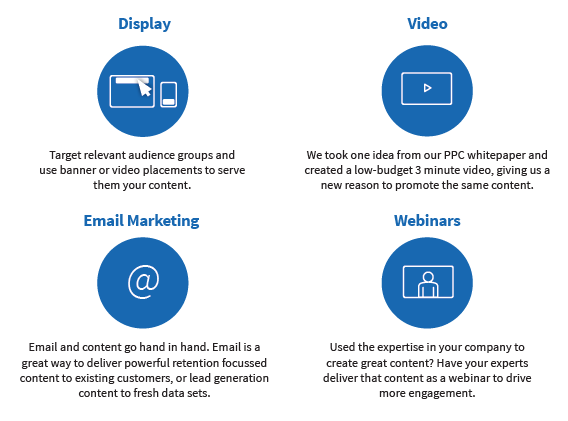
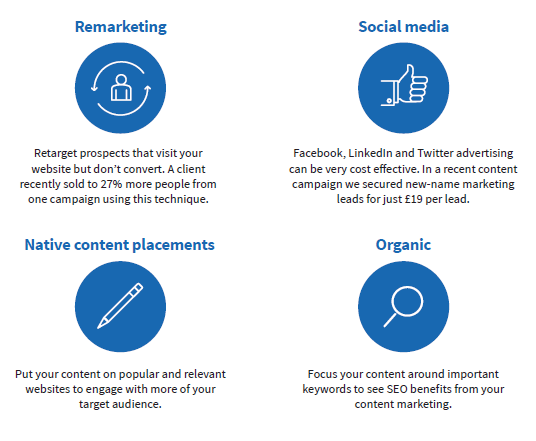

At Elixirr Digital, we’ve produced all kinds of different content both for our own marketing activity and for our clients.
Below you’ll see examples of some different content types and how we’ve used them to create content for ourselves and for our clients.
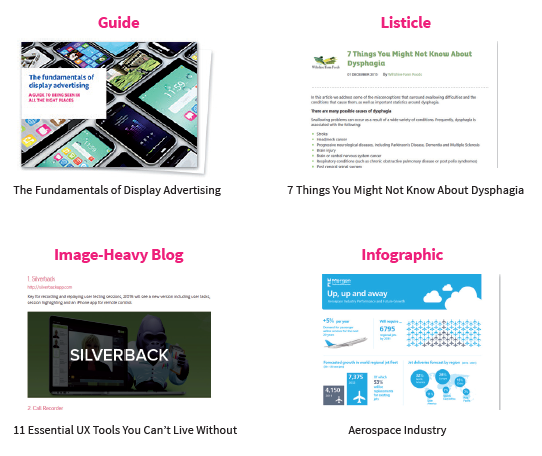
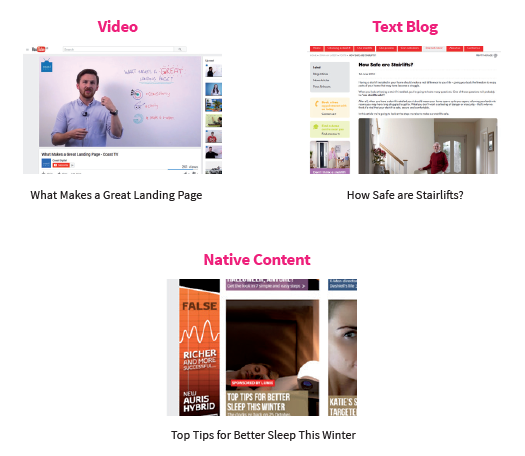

To achieve a more scientific approach to Content Marketing, you need to break it down into two constituent parts:
- Your objectives – what you’re trying to achieve
- Your content – what you’re going to produce
These two elements should be influenced by and inform each other.
Content objectives
- Lead generation
- Retention (brand loyalty)
- Social engagement
- Brand awareness
- Increasing sales
Each of these objectives requires a different approach, a different type of content and different targets.
Your objective might necessitate a piece of content specifically tailored for Social Media – however, if you have more complex goals and the required understanding of your audience, you could be looking at a more involved, multichannel Content Marketing campaign.
How to align your content with your objective
You’ve learnt about your audience and you know your objective. Now you need to put it all together and create your content.
Now we’ll look at how you do that. What kind of content should you be producing? Where and how is it going to succeed? Read on to find out.

If you’re looking to put more names in the pot, a comprehensive content marketing strategy can help you to reach out to potential customers at specific points in their journey toward conversion.
When you offer multiple services or products, creating a piece of content that focuses on one area can be a useful tool to help you segment your audience – if potential customers show interest in a piece of content focused on a particular service, then you know, when following up on that lead, which product to push.
How content generates leads
One strategy is to create a useful piece of content. Then, require prospects to complete a form that captures their information. In return, they get access to the content.
It’s essentially an exchange – the prospect’s information for a useful piece of content.
The key here is to provide something of value, otherwise the whole exercise is a waste. If you capture a prospect’s information, but they feel let down or cheated due to the poor quality of the content you provide, then they are unlikely to hold your brand in high regard.

Content can be used throughout the conversion funnel, not only to add names to the top of the funnel but also throughout the stages of the customer journey.
Understanding your audience, and how they journey towards purchase, is key. Questions you need to ask include:
- Are they first time customers or have they bought from you before?
- What barriers prevent a first time buyer from making a purchase?
- What might prevent a buyer from returning to make a second purchase?
Use your data
With access to remarketing lists you can deliver educational content to new customers to help them transition out of the research phase of their user journey, while more advanced content can be used to help create repeat customers.

Retention is all about getting back in front of customers at the right time, reengaging them and bringing them back into the fold.
We’ve seen that by delivering an email to ‘lapsed’ customers, who have fallen out of common buying behaviour, we can retain and convert those people. You can do the same with content marketing.
Content as re-engagement
Re-engaging customers through content is a case of putting something interesting in front of them when you need them to remember your brand.
With channels like Email and Social Media, we have the tools necessary to do just that.
The key here is to create a positive interaction with your brand – giving them good reason to purchase from you again.

‘Social Engagement’ is a broad term, so while it’s a valid objective it’s also important to clarify what you want.
What are your goals on Social Media?
- Shares
- Likes/follows
- Click-throughs
Who are you reaching out to?
- Customers (B2C)
- Professionals (B2B)
Who they are influences which network you should use – and the network you use influences the content you produce. Saying you want Facebook likes for B2B may not be the best
approach. You could be missing out by not using LinkedIn.
Other things to consider – on Twitter, people click out. However, for Facebook you may be better served by in-feed video content.
However, your objective is still important. For example, as in-feed video is unlikely to generate clickthroughs.
About Likes
What do Facebook ‘likes’ really mean?
They give you more organic reach for your posts and maybe a better picture of who is interested in your business.
Facebook ‘likes’ help you to succeed, but they’re not necessarily an objective but rather a means to an end.

Before you can generate sales, you often need to put your brand in front of people – building both the knowledge of what you do and trust that you do it well.
There are three great ways you can put your content in front of a large section of your audience:
- Social Media
- Display Advertising
- Native Content
As always, you need to tailor your content to the medium it’ll be appearing in as well as your objective.
Brand awareness content needs to work harder
To maximise the brand awareness you can achieve from a piece of content on Social Media you want something that your audience will want to share – this massively increases your potential reach.
With brand awareness content you need to create something that will grab your audience and quickly make an impression. Perhaps most importantly, it needs to be memorable – if they don’t know your brand by the end of it, then it hasn’t done its job!

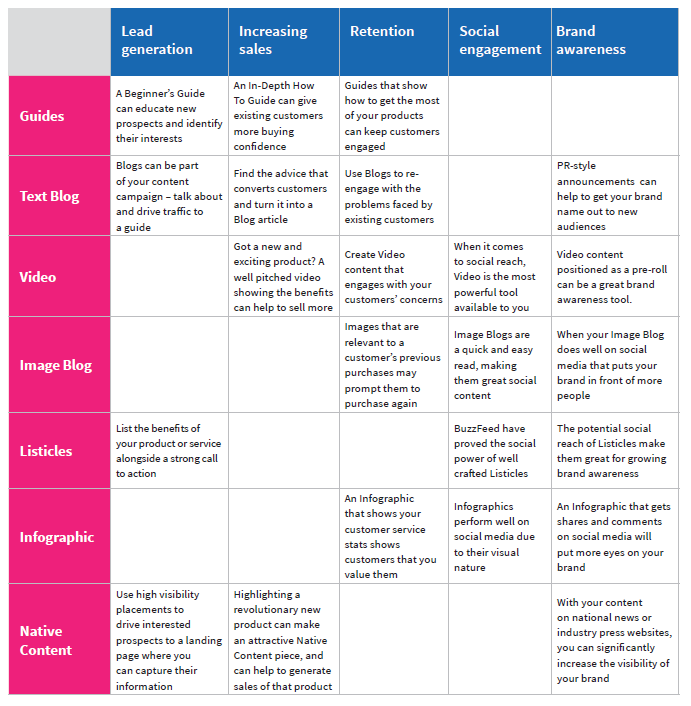

We mentioned before how competitive the digital landscape is – meaning it’s not as simple as just throwing together a blog and watching the sales roll in.
As we said before, you need to stand out from the crowd. To help you do this, here are 5 top tips for creating quality content!
Our top 5 content creation tips
1 – Get the length right
Human beings are instinctively inclined to think that bigger is better, but in the world of content marketing this isn’t always the case.
Research has shown that, if a user lands on a page with content they find too bulky or overwhelming they will almost always hit the back button.
This same principle applies to a video on Social Media or an Email pitching your beautifully crafted beginner’s guide.
You need to make sure your content is the right length for where it’s going to be seen and for the audience that are going to be seeing it.
Even if someone is reading your blog, if you know your audience is time poor then a big bulky blog article is never going to work for them.
2 – Be practical
Giving your readers something they can use is a great way to give them a positive interaction with your brand. Helping them solve a problem or giving them new and useful information is a tried and tested way of adding value.
3 – Answer customer questions
One quick way to create helpful content is to look at the most common questions your customers ask.
By identifying common queries and tackling them through content, you give customers a quick and easy way to get the answers they need.
Firstly, this is a great user experience. Secondly, it might take some stress off your customer service team!
4 – Power of imagery
The well known saying that a picture paints a thousand words is one worth paying attention to when you’re producing content for online consumption.
Analytics show that content that uses imagery to break up or supplement text receives more attention from users. Websites that use quality photography also tend to see higher rates of engagement and conversion.
If you’re looking to create content that resonates on Social Media then imagery is particularly important, if only because networks like Facebook prioritise image or video content – because that’s what users want to see.
5 – Headline/title importance
While it’s important that your content is high quality, the area that perhaps needs the most investment in terms of time and effort is the headline or title.
If no one clicks through to your content, then it doesn’t matter how good it is – that’s why some people advise you spend up to 80% of your time on the headline.
Bonus tip
As a marketer, you might not have the expert technical knowledge of a software developer – however, if you’re writing content on that subject then that knowledge can help achieve the high quality you’re after.
So, collate from around the business – you might not know the answers to advanced questions, but you most probably work with someone that will.

Content is an important part of your approach to Digital Marketing – it’s integral to most of your activity, so it’s vital you get it right.
We love the unique challenges presented by Content Marketing and we’d love to help you meet those challenges.
Download the guide






